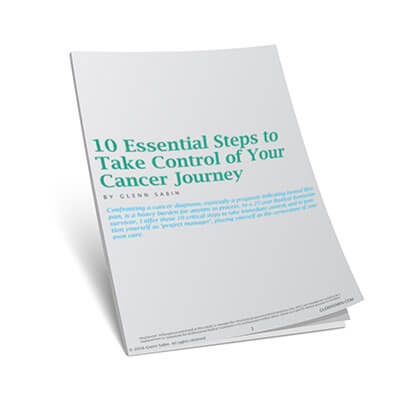If you are reading this you probably know my story: I was diagnosed with chronic lymphocytic leukemia at 28 years young (in 1991); created an integrative health wellness approach shortly thereafter; was closely monitored by top academic oncologists; and, by 2012 cleared my marrow of what is deemed incurable leukemia… without conventional cancer treatment.
Seven years later I have no signs of disease. But my health regimen continues unabated, as if I had measurable or even raging disease.
I will never let my guard down. It doesn’t mean I am over-the-top nuts (depending on who you ask, naturally), following all that my program comprises, though I am quite disciplined. Put simply, I am serious about maintaining my health, and hope to avoid a relapse, or the possibility of being diagnosed with another disease, be that a secondary cancer or some other condition(s) in the future.
Am I cured? That’s not the point. I am healed. Healing is different than curing.
My Anti-Cancer Regimen is Sacred
To me, this is not work. There is no drudgery in my regimen. It is what I have been conditioned for, over decades, as my ‘normal’. It’s simply how I roll. My way of living makes me feel amazing—emotionally and physically. It’s not a diet or workout routine per se—it’s my chosen lifestyle; I know of no other way to live. And, to the extent possible, I will allow no one and no event to take it away from me.
Half My Life as a Survivor Thriver
This fall will mark 28 years since I was diagnosed at 28 years old. This means I will have been a cancer survivor thriver for half my life. Candidly, this is a ginormous personal milestone—just striking the keys to write this line is nothing short of exhilarating. This journey has shaped who I am. It has greatly informed my priorities, and influenced a passion to help others avoid some hard lessons that I’ve had to learn over decades. In many ways, yes, cancer has also helped define me.
Lifestyle Choices Before and Along the Journey
Harmful lifestyle choices often—though not exclusively—enable the onset of many types of cancer, and have the capacity to fuel the disease. Once diagnosed, only a few people review their lifestyle choices and overhaul their practices. It’s true, some people make a few slight changes while undergoing active treatment—a temporary adjustment—but too many people do not change their lifestyle or incorporate new wellness routines after being diagnosed with cancer.
Sadly, an even smaller number of survivors maintain a sensible lifestyle post treatment and over the long-term. Even those who make an effort to embrace multiple healthy avenues return to their old ways as soon as they hear the ‘all clear’ five-year post-diagnosis proclamation from their oncologist.
[Handpicked Related Content: Living With Cancer in the Context of Dalai Lama]
It is mind-boggling to me that there are still those who bring McDonald’s and soda to their chemo appointments. Sugary snacks and hard candies are still featured in many oncology reception areas. (I guess fresh fruit is too expensive.)
For the bulk of patients that fall into the category of making ‘unhealthy lifestyle choices’—and those among them diagnosed with potentially life-limiting diagnoses—short of a seismic intervention in the form of comprehensive cancer prevention education… the writing is on the wall. The probability of a deep and durable remission, high quality of life, and overall survival, is greatly diminished—and can be literally out of reach.
One Pivot at a Time
Adhering to a high quality lifestyle is challenging for most people. It takes structure and discipline. It does not happen overnight. The thing is, it shouldn’t happen overnight; it just needs to happen. Depending on where someone begins their ‘shift’, it is easy to be overwhelmed. Taking in too much information, or trying to implement too much too quickly, can stall or halt positive change. Slow and steady progress over time often ensures adherence.
My coaching clients are often predisposed for, and ready to, incorporate significant lifestyle change. Most are savvy health consumers, have likely read my book n of 1, and/or have been following my writing here for a while.
[See Glenn Sabin’s Anticancer Foods List]
But others require a Herculean shift. For those not regularly moving their bodies, not drinking enough filtered water, and for those who regularly eat processed and sugar-laden foodstuffs and beverages, and occasionally smoke, drink alcohol, and are over-stressed… well, this requires a phased-in approach that will take time. But not too much time. It’s a double edged sword: change all at once nets a low buy-in and adherence—for most it’s just too overwhelming, but change over an extended period of time can come too late in the game.
In addition to all things behavioral change and critical timing, there is the issue of access to top oncology experts and accurate diagnoses: some folks are being seen by the appropriate oncologists at the right clinics and institutions, while others have neither gotten second (or third) opinions, nor become aware of the many options and treatment approaches—because they are not getting the best information from the most reliable sources— including experimental drugs and trials.
What I do know is this. Regardless of where you start on your own unique ‘healing over cancer’ journey, once you…
- put all of the accurate ‘disease’ information and healthy pieces into place;
- are well-conditioned, devouring the lifestyle ‘regimen’ as your own…
…you become the healthiest you who happens to be hosting an underlying malignant health challenge. You become a horrible host to cancer.
Are you then better positioned for your journey—regardless of outcome—than most? Unequivocally, yes!
Never Let up.
Join my private Facebook Group Anticancer Thrivers—a community forum for achieving your best life while living with cancer.
Photo credit: www.bigstockphoto.com/MihailoK


